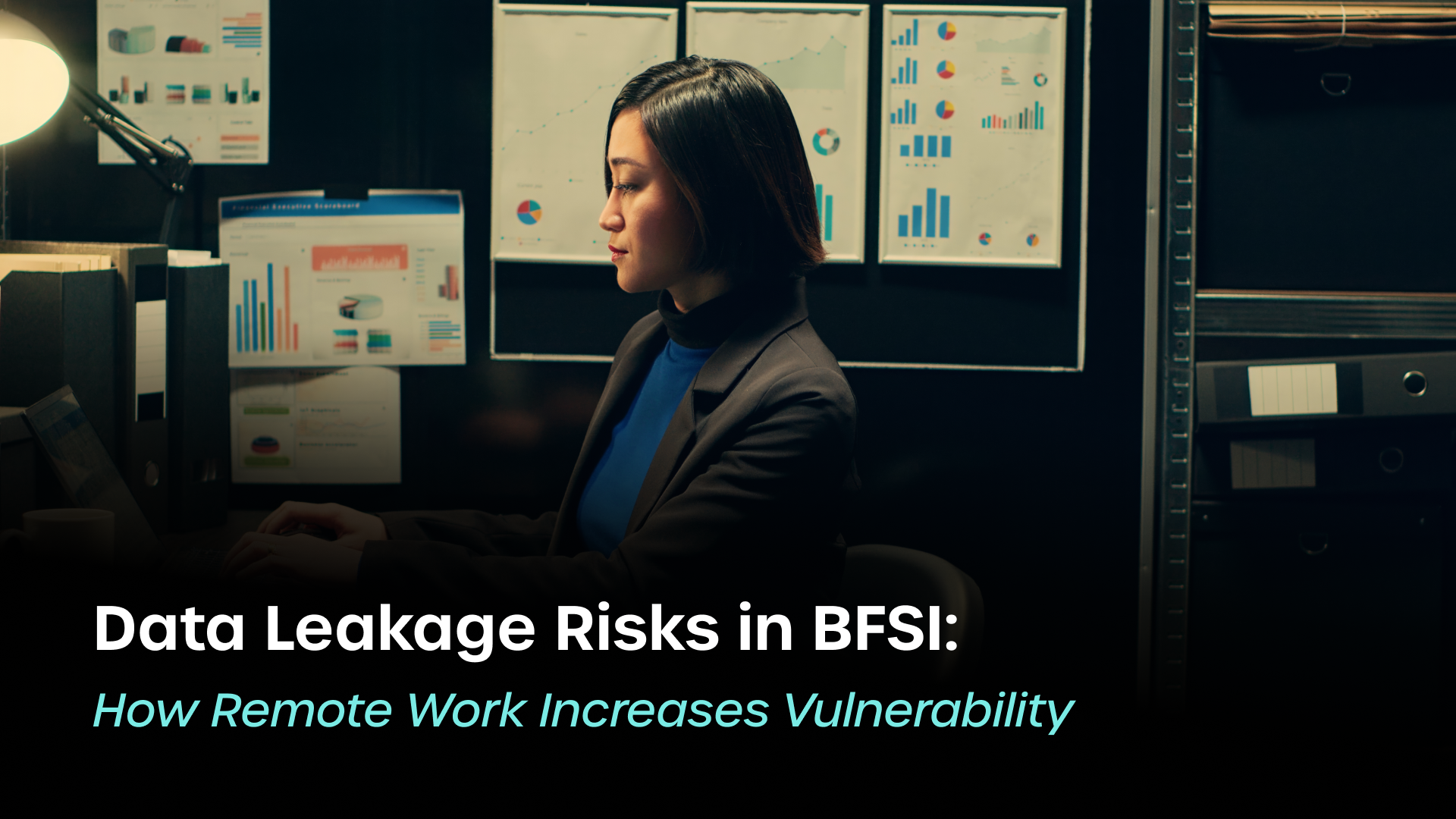
Data Leakage Risks in BFSI: How Remote Work Increases Vulnerability
- Rajnish Kumar
- 6 Mins

Summary
In the modern financial landscape, BFSI data leakage protection has become a critical priority for banks, insurance companies, and other financial institutions.
In the modern financial landscape, BFSI data leakage protection has become a critical priority for banks, insurance companies, and other financial institutions. With remote work becoming commonplace, sensitive financial data is increasingly exposed to risks that are easier to manage in office environments. From client account information to internal reports, protecting this data is no longer optional—it’s essential for maintaining trust, regulatory compliance, and operational integrity.
Remote work offers flexibility and efficiency, but it also introduces vulnerabilities. Employees accessing sensitive systems from home or mobile devices can inadvertently expose confidential information. That’s why organizations are turning to using solutions like enhanced Data Loss Prevention (eDLP) to secure their operations, mitigate risks, and maintain financial data protection across distributed teams.
Why Remote Work Increases Data Leakage Risks
Remote work has transformed the way financial institutions operate, but it also expands the attack surface for data leaks:
- Unsecured Devices and Networks: Employees may access banking systems using personal laptops or public Wi-Fi.
- Multiple Access Points: Client and internal financial data is accessed across remote endpoints, increasing exposure.
- Collaboration Tools: Cloud-based platforms, messaging apps, and file-sharing services can introduce accidental leaks if not properly secured.
- Human Error: Even experienced staff may mistakenly send sensitive information to the wrong recipient.
Without proactive measures, these factors can lead to data leakage, regulatory violations, and reputational damage.
Common Types of Data Leakage in BFSI
Financial institutions face unique risks when it comes to data leakage:
- Client Information Exposure
Personal details, account numbers, and transaction history may be inadvertently shared. - Internal Data Breaches
Reports, financial forecasts, and sensitive strategic documents can be accessed by unauthorized personnel. - Insider Threats
Employees with privileged access may misuse information intentionally, leading to fraud or compliance issues. - Regulatory Non-Compliance
Financial institutions are subject to stringent regulations like PCI DSS, GLBA, and local banking compliance rules. Failure to secure data can result in heavy fines and operational restrictions.
To address these risks, organizations are implementing remote banking security protocols and leveraging BFSI data leakage protection tools.
How eDLP Protects Financial Institutions
Enhanced Data Loss Prevention (eDLP) is specifically designed to prevent sensitive data from leaving secure systems, whether accidentally or intentionally. It goes beyond traditional monitoring by actively blocking risky actions and providing real-time oversight.
Key features include:
- Real-Time Risk Prevention
Stops unauthorized sharing of sensitive financial information. - Device and Application Monitoring
Ensures only approved devices and software can access sensitive data. - Policy Enforcement and Alerts
Automatically enforces internal compliance policies and notifies IT teams of suspicious activity. - Audit-Ready Reporting
Creates detailed logs for regulatory compliance, reducing audit preparation time.
With eDLP, financial institutions can maintain financial data protection while supporting remote teams efficiently.
Preventing Insider Fraud with eDLP
One of the most critical benefits of eDLP is its ability to prevent insider fraud:
- Privileged Access Control
Limits what employees can access based on roles and responsibilities. - Behavioral Monitoring
Detects unusual activity that may indicate fraudulent behavior. - Automatic Intervention
Blocks risky actions before they compromise data integrity.
By proactively monitoring insider activity, eDLP reduces both intentional and accidental breaches, giving compliance and security teams confidence that sensitive information is safe.
Best Practices for BFSI Data Protection in Remote Work
To strengthen remote banking security and minimize leakage risks, financial institutions should:
- Implement eDLP Across the Organization
Protect client data, internal reports, and sensitive communications. - Secure Endpoints and Networks
Require VPNs, encrypted connections, and device management policies. - Educate Employees
Regularly train staff on data handling best practices, phishing awareness, and remote work protocols. - Regularly Audit Access and Policies
Review logs, update policies, and monitor system activity to maintain compliance and minimize exposure. - Integrate eDLP With Existing Systems
Ensure seamless monitoring across core banking platforms, communication tools, and document management systems.
Benefits of eDLP for Financial Institutions
Implementing eDLP solutions provides multiple advantages:
- Reduced Data Leakage Risk: Prevents accidental or intentional exposure of sensitive financial information.
- Stronger Regulatory Compliance: Maintains audit-ready records and ensures adherence to financial regulations.
- Insider Threat Prevention: Detects and stops fraudulent behavior proactively.
- Remote Workforce Protection: Ensures staff can work from home or other locations without compromising security.
- Operational Confidence: IT and compliance teams can focus on strategic initiatives instead of firefighting breaches.
Conclusion
As remote work continues to shape the BFSI landscape, BFSI data leakage protection is no longer optional—it’s essential. Financial institutions must adopt robust security measures, including eDLP, to safeguard sensitive client and internal data, maintain financial data protection, and ensure remote banking security.
Proactively preventing insider fraud, securing endpoints, and implementing real-time monitoring tools allow organizations to balance productivity and security. With the right eDLP strategy, financial institutions can protect their data, stay compliant, and build trust with clients, even in a remote work environment.
1. What is RemoteDesk?
2. How does RemoteDesk ensure compliance with regulations like PHI, HIPAA & PCI DSS?
3. Can RemoteDesk integrate with our existing security and productivity tools?
4. How does RemoteDesk handle remote and hybrid workforce management?
5. What types of analytics and reporting does RemoteDesk offer?
Get Started Today
Sign up in minutes. Secure your remote
workforce with confidence.
See how RemoteDesk makes compliance and data protection effortless.




